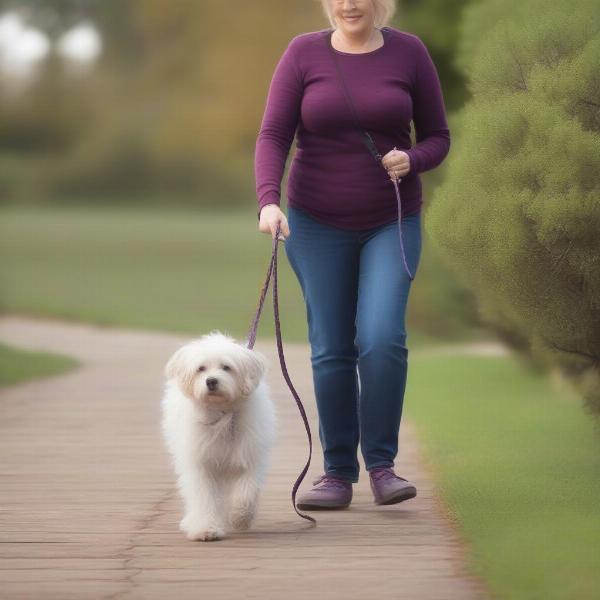Slip leads, also known as slip collars or choke chains, are a type of dog lead that tightens around the dog’s neck when pulled. They are a popular choice among dog owners for their ease of use and control, but they can also be controversial due to the potential for misuse and injury. This guide will provide a comprehensive overview of slip leads for dogs, covering their uses, benefits, drawbacks, and important safety considerations.
Understanding Slip Leads
Slip leads are essentially a loop of material, typically nylon or metal chain, that can be adjusted to fit around a dog’s neck. When the dog pulls, the loop tightens, applying pressure to the neck and discouraging pulling behavior. When the dog walks nicely, the lead loosens, releasing the pressure. This mechanism allows for quick corrections and control, particularly useful for training and handling energetic or strong dogs.
However, it’s crucial to understand that slip leads can be harmful if used incorrectly. Excessive pulling or jerking on the lead can cause choking, tracheal damage, and neck injuries. Therefore, proper training and understanding of how to use a slip lead correctly are essential.
Benefits and Drawbacks of Slip Leads
Slip leads offer certain advantages, particularly for training and control. Their quick-release mechanism allows for immediate corrections, which can be helpful in teaching dogs to walk politely on a leash. They are also lightweight and easy to carry, making them a convenient option for walks and training sessions.  Dog Walking with a Slip Lead
Dog Walking with a Slip Lead
However, the potential for misuse is a significant drawback. Improper use can lead to serious injuries, including choking, strangulation, and neck damage. Slip leads are not recommended for dogs with respiratory problems, neck injuries, or behavioral issues that cause excessive pulling. They can also exacerbate reactivity and aggression in some dogs.
Choosing the Right Slip Lead
When choosing a slip lead, consider the material, size, and construction. Nylon slip leads are generally gentler on the dog’s coat than chain leads. The size of the lead should be appropriate for the dog’s breed and neck size. A lead that is too large can slip off, while a lead that is too small can be restrictive and uncomfortable. Look for leads with sturdy hardware and well-stitched seams to ensure durability and safety. best slip leads for dogs
How to Use a Slip Lead Safely
Proper usage is crucial for preventing injuries and ensuring the effectiveness of a slip lead. The lead should be positioned high on the dog’s neck, just behind the ears. When correcting, use short, gentle tugs rather than harsh jerks. Avoid constant pressure on the lead, as this can cause discomfort and encourage pulling. slip leads for small dogs
Training with a Slip Lead
Slip leads can be a useful tool for training, but they should be used in conjunction with positive reinforcement techniques. Reward your dog for walking nicely on the lead with treats, praise, and encouragement. Avoid using the slip lead as a punishment tool. best slip lead for dogs uk
Alternatives to Slip Leads
Several alternatives to slip leads offer similar control without the same risks. Harnesses, for instance, distribute pressure across the dog’s chest and shoulders, reducing strain on the neck. Martingale collars provide a limited slip effect while preventing choking. Fixed-length leads offer consistent control and are suitable for everyday walks. slip leads for large dogs
Conclusion
Slip leads can be a useful tool for dog owners, but they require proper understanding and usage. When used correctly, they can provide effective control and aid in training. However, misuse can lead to serious injuries. Always prioritize your dog’s safety and well-being when choosing and using a slip lead. Consider alternatives like harnesses or martingale collars, especially for dogs prone to pulling or with sensitive necks. strong dog leads for large dogs
FAQ
- Are slip leads cruel? When used incorrectly, slip leads can be harmful. Proper training and gentle handling are essential.
- What size slip lead should I use? The size depends on your dog’s breed and neck size. Consult a pet professional if unsure.
- Can I use a slip lead on a puppy? It’s generally not recommended to use slip leads on puppies.
- What are the alternatives to slip leads? Harnesses, martingale collars, and fixed-length leads are safer alternatives.
- How do I train my dog to walk on a slip lead? Use short, gentle corrections combined with positive reinforcement.
- Are slip leads suitable for all breeds? No, some breeds are more susceptible to neck injuries and should not use slip leads.
- Where can I buy a good quality slip lead? Pet stores and online retailers offer a variety of slip leads.
ILM Dog is a leading online resource dedicated to providing dog owners worldwide with reliable and practical advice on all aspects of dog care, from breed selection to senior care. Our team of experts provides in-depth information on dog health, training, nutrition, grooming, and much more. We help you choose the right products for your furry friend, ensuring their health and happiness. Contact us today for personalized advice! Email: [email protected] Phone: +44 20-3965-8624. Visit ILM Dog for expert guidance on everything dog-related.